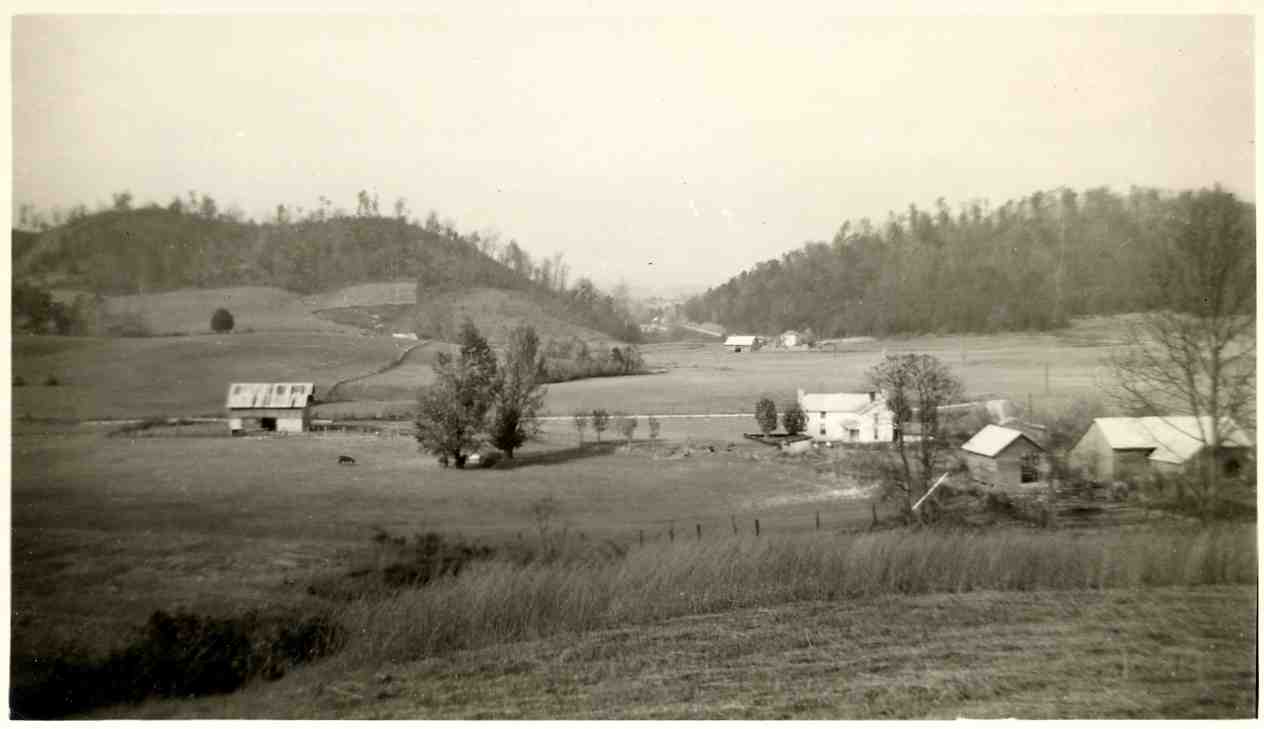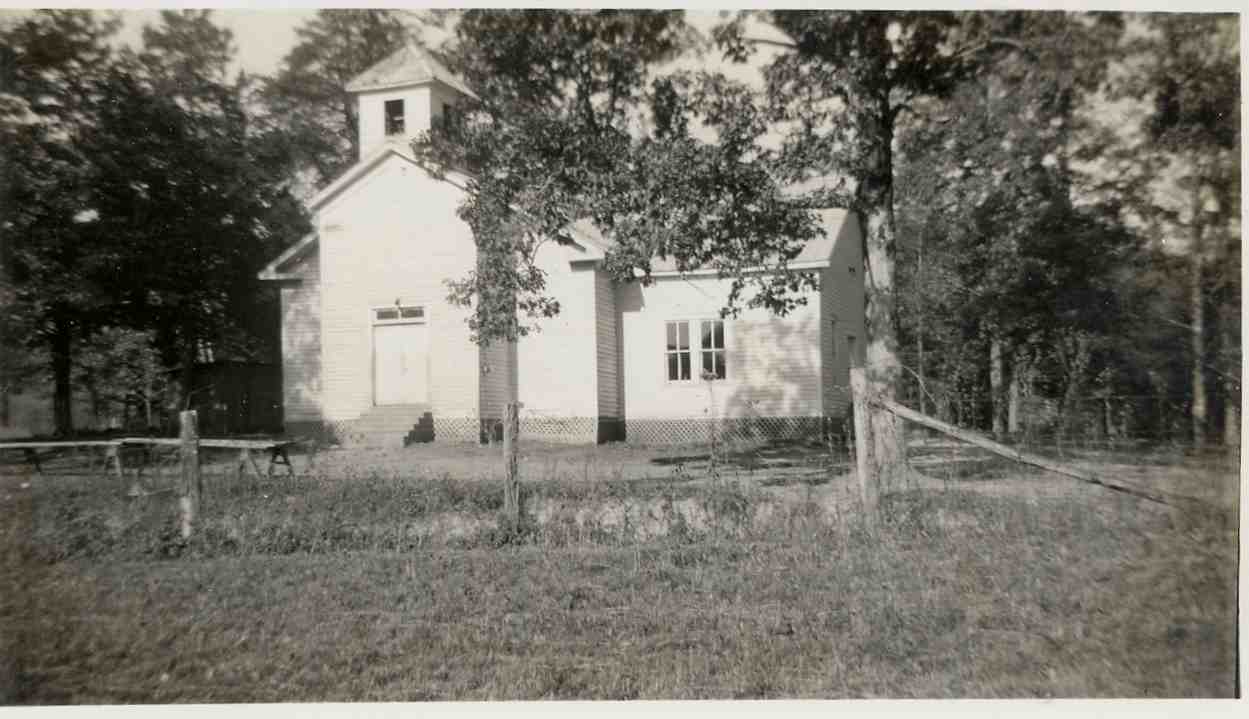

This 60-plus-year-old photograph was taken at George Anderson’s residence looking to the north, where his house stood on the south side of present-day New Hope Pond Road, which was Bear Creek Road in 1942.
|
|
|

Bounded on the Southeast by Chestnut Ridge and on the Northwest by Pine Ridge, Bear Creek Valley lies nestled between these ridges and is generally approximately ½ mile wide. The valley runs Southwest from Scarboro Road across Highway 95 and on to the Clinch River and Highway 58. However, the primary section of most interest and also most mystery is the section at the head of the valley bordering Scarboro Road. The Y-12 National Security Complex fills the valley from ridge to ridge at this location and extends approximately three miles into the valley. A recent development that is growing in significance is the Environmental Management Waste Management Facility, a huge specialized landfill located west of Y-12 and designed to contain the contaminated waste from the demolition of buildings at the K-25 Manhattan Project era site. So many trucks will be traveling to this location over the next few years that a major “haul road” requiring two large bridges is being built from the demolition site to the landfill. Much of this haul road will run up Bear Creek Valley.
A LITTLE MYSTERY
Bear Creek Valley has an intriguing and mysterious history. Where did it get such an unusual name? Did Indians name it? Many other features of this area seem to have been originally named by the Cherokee or earlier occupants of the land. Pellissippi is an example of a name that is of difficult origin (There is no “P” sound in the Cherokee syllabary). And there is that mysterious John Hendrix prophecy that identified Bear Creek Valley as the location where the factory would be built that would “help win the greatest war there would ever be.” And of course, there is that “Y-12” nuclear weapons place with its secrecy and security. Finally, an unusual geological feature causes two streams to exit the valley, one on each end. Bear Creek runs Southwest and East Fork Poplar Creek runs Northeast out of the valley and across the mouth of the valley through a gap in Pine Ridge into the city of Oak Ridge.
Let’s examine the unusual history of Bear Creek Valley. First, the valley was named for an event that has been passed down as a story through the descendents of the man who created the legend of a bear that was killed with a double bladed axe on the creek in what came to be known as Bear Creek Valley. I had heard something about a bear being killed in the valley, but had not been able to confirm the story although I had asked a lot of folks if they knew the story. None did. None, that is, until Saturday, June 14, 2005. At the volunteer project to clean up the New Hope Cemetery, I happened to talk to Charles Manning who said: “I know the story about how Bear Creek Valley got its name.” Well, you could have knocked me over with a feather. Here I was searching everywhere for someone who knew that story and now here this fellow just comes up to me and says that he knows the story. I immediately asked if I could get the details from him.
Charles then told the full story of how Bear Creek Valley got its name. It seems his Great Grandfather, Henry Holloway on an occasion when he was considerably drunk on homemade liquor (later known as “moonshine”) said he was going to go kill a bear. He proceeded to take a double-bladed axe from the woodpile, sling it across his shoulder and stumble drunkenly off in the direction of the valley just through the gap in the ridge near his home. It is said that he went “out and down the valley here and he come back with a big ole black bear.” This story was told to Charles Manning by his Grandfather, Edger Holloway and was told about Edger’s father, Henry Holloway. Edger said the valley was called “Bear Creek Valley” after that event. It seems evident that Henry Holloway must have told folks that he killed that big ole black bear on the creek in the valley over yonder. Henry Holloway came to this area in 1820 and first lived at Wartburg. He moved in Scarboro in 1830. So, Bear Creek Valley was named after 1830. Charles was delighted to tell me the story and rightfully took some pride in knowing the true history of how Bear Creek Valley got its name. He seems especially proud that an ancestor of his was responsible for the name.
Next let’s look at the John Hendrix prophecy story. But before we do that, where do you suppose John Hendrix was born? Bear Creek Valley, of course! When I was editing Grace Raby Crawford’s “Back of Oak Ridge,” I talked to her about John Hendrix. She was born three months after he died. John Hendrix’s stepdaughter, Paralee Raby, adopted Grace when she was a very small girl and raised her. Grace has very fond memories of Paralee. Paralee is also the person who took care of John Hendrix until his death after he got tuberculosis. He gave her his 15-acre farm for taking care of him when he was dying. John is buried in Hendrix Creek sub-division in Oak Ridge, Tennessee. I asked Grace where she thought John Hendrix would have been born. She said it had to be Bear Creek Valley as that was were his parents lived at the time. She helped me locate the exact house they lived in. I took aerial photographs made before 1942 and maps that showed the roads then as well as the houses. She was sure the house was just Northeast of the intersection of Mount Vernon Road and Bear Creek Road. She said it was the second house Northeast of the intersection and was located on the South side of the road. That is exactly where the maps and aerial photos put the house. The present location where the house where John Hendrix was born once stood is now the busiest intersection in the west end protected area of Y-12. It is at the Northeast corner of Building 9201-4, one of the original “Alpha” buildings that housed the original calutrons.
John Hendrix was born in 1865 in the middle of Bear Creek Valley, just about exactly where the enriched uranium was produced in 1944-45 that was used to drop a bomb on Hiroshima…helping to win the greatest war the world has known. Now how about that!
John died in 1915, but he had his vision around the turn of the century…some 40 years before the Manhattan Project. He also predicted a city on Black Oak Ridge, a railroad spur along his property line, the “seat of power” exactly where the Federal Office Building is now located, and of course the location of Y-12 in Bear Creek Valley.
Another character who was known to travel the woods in Bear Creek Valley was Silas Hulan. Silas was known as a person who “roamed the hills” and would come up to people’s homes seeking food but would not usually come in the houses. On one occasion, Charles Manning’s Grandfather, Edger Holloway, got him to come in on a very cold night and sleep by the warm fire in the family fireplace. This was the only time Edger ever knew of Silas agreeing to come in anyone’s home. People would feed him but he would not come into their homes.
Next let’s look at the community that developed at the northeast end of Bear Creek Valley prior to the Manhattan Project. Pre-1942 property maps of the area where Y-12 now exists show that many farmsteads were established throughout the area. One of the more prominent communities formed by these farmsteads was the New Hope Community, which was located near the junction of Bear Creek Road and Scarboro Road (east end of Y-12). The New Hope Cemetery (No.32), and the nearby Jackson Cemetery (No. 33) are almost all that remains of this community. The New Hope Baptist Church once stood as a center point of the community, just east of the New Hope Cemetery. The church and other buildings in the community were dismantled in 1942 after residents were displaced for the “war effort”. The project area, known initially as the Kingston Demolition Range, was quickly fenced in and guarded by the U.S Army Corps of Engineers. By 1943, the project area was known as the Clinton Engineer Works.
One of the farms of that era was that of the George Anderson family, located between the New Hope and Jackson Cemeteries. Mr. Anderson visited the Y-12 Complex in 2004 to see the location of his former farm, and to point out the location of former landmarks as shown on available photographs. Mr. Anderson noted that considerable changes had occurred to the topography. For instance, the Jackson Cemetery did not sit high on a knoll as it does today. Considerable bulldozing and grading was performed in 1942 and 1943 in preparation for the Y-12 Plant construction. The east end of Y-12 served a number of uses, including a fuel depot, a staging area for construction materials, and a pistol range for the security force.
So, Bear Creek Valley has a full history even before the history of its most famous occupant, Y-12. Known then as the Y-12 Plant and made up of nine major buildings and support facilities, the whole industrial development was built in 18 months. It was a key facility of the Manhattan Project of the 1940’s that succeeded in stopping World War II by creating the required Uranium 235 for the “Little Boy” bomb that was dropped on Hiroshima. Over the years, the Y-12 National Security Complex has continued to serve as a national resource supporting the nuclear weapons requirements. Y-12 is now the world’s most secure storage facility for enriched uranium and a key facility in the nation’s nuclear weapons program. Over the years, many history-making events have taken place there and the technology developed for machining nuclear weapons has been used to help industry fix difficult problems while maintaining the nuclear weapons capability. The Moon Box, a solid block of aluminum machined at Y-12 was used to contain the rocks picked up from the moon and brought back to earth. The Seawolf submarine needed a special propulsor and Y-12 made one. Y-12 is a National Prototype Center. Over the years, Y-12 has never missed a single weapons delivery shipment and by producing so many weapons in the 1980’s played a significant role in the economic downfall of Russia that led to the end of the “Cold War.” Nuclear nonproliferation is also a major concern for Y-12 as evidenced by the enriched uranium brought to the site from Kazakhstan in the mid 1990’s and the equipment from Libya in 2004. Now for the first time ever, Y-12 has allowed the public to see the historic Beta 3 Calutrons, the actual machines that separated the Uranium 235 for the first atomic bomb. History in the making!
Bear Creek Valley continues to produce intriguing history.
Other Oak Ridge, Tennessee Links:
American Museum of Science and Energy
Oak Ridge Convention and Visitor's Center
Historical Markers in Oak Ridge
Oak Ridge History
Secret City History
Hymn to Life
John Hendrix and Y-12
Back of Oak Ridge and John Hendrix (Prophet of Oak Ridge) book
Secret City The Movie
Calutrons - Plowshares Story
Please send any questions, comments or suggestions about this page to Comments